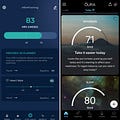Lots of confusion when it comes to wearables. In this short blog, I’d like to try to clear up one of the most important points.
When you use a wearable, presumably to measure your body's response to what you are doing (stressors), you have two options:
1) Looking at the physiology. For example your resting heart rate, pulse rate variability, temperature, etc. That's how your body responded.
2) Using a made-up score that includes your behavior and as such, becomes some sort of self-fulfilling prophecy.
Check out the simple example below: I was more active and I slept a bit less, my readiness must be low (behavior, not physiology, results in a low score, as the algorithm makes assumptions about how we should be responding to a certain behavior, despite the fact that of course, we might not be responding that way).
However, my physiology is in fact showing a very good response, on the top end of my normal range (see the left side screenshot, from HRV4Training).
Here the same data has been used. It is not a matter of measuring different things, it is how that information is used. I've read in HRV4Training my HRV from Oura, which was 83 ms in rMSSD.
Wearables can be informative if we use them to look at what our body is saying, as opposed to what an algorithm thinks we should be feeling based on our behavior.
Please, let’s move away from made-up scores and let’s start looking at the physiology instead.
Marco holds a PhD cum laude in applied machine learning, a M.Sc. cum laude in computer science engineering, and a M.Sc. cum laude in human movement sciences and high-performance coaching.
He has published more than 50 papers and patents at the intersection between physiology, health, technology, and human performance.
He is co-founder of HRV4Training, advisor at Oura, guest lecturer at VU Amsterdam, and editor for IEEE Pervasive Computing Magazine. He loves running.
Social:
Twitter: @altini_marco.
Personal Substack.





